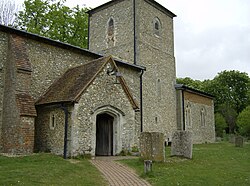Radnage
| Radnage | |
|---|---|
 St. Mary's parish Church |
|
| Radnage shown within Buckinghamshire | |
| Population | 658 673 (2011 Census) |
| OS grid reference | SU7897 |
| Civil parish |
|
| District | |
| Shire county | |
| Region | |
| Country | England |
| Sovereign state | United Kingdom |
| Post town | High Wycombe |
| Postcode district | HP14 |
| Dialling code | 01494 |
| Police | Thames Valley |
| Fire | Buckinghamshire |
| Ambulance | South Central |
| EU Parliament | South East England |
| UK Parliament | |
| Website | Radnage |
Radnage is a village and civil parish in the Wycombe District of Buckinghamshire, England. It is in the Chiltern Hills about two miles north east of Stokenchurch and six miles WNW of High Wycombe.
The parish is set in folds of the Chiltern Hills to the south of Bledlow Ridge next to the border with Oxfordshire. Although not a large parish, the residential areas known as the City, Bennett End and Town End, are separate hamlets.
Radnage (also spelled Radeneach, Rodenache etc. in old documents) meant ‘red oak’ in Old English.
Settlement in the area dates back to Roman times as demonstrated by the excavation of a Romano-British glass ribbed bowl from the village, now in the British Museum. Radnage is not mentioned in Domesday Book and it appears from a 13th-century document to have been royal demesne attached to the manor of Brill. Later, it was divided into two parts. The smaller part was granted by King Henry I to the newly established Fontevrault Abbey in France and attached to property at Leighton in Bedfordshire, which was also given to Fontevrault.
The larger part, known as Radnage Manor, was for a time retained by the crown and then in 1215 was granted by King John to the Knights Templar. When this order was suppressed in the early 14th century, their lands passed to the Knights Hospitaller. On the Dissolution of the Monasteries by King Henry VIII the manor was again acquired by the crown. King Charles I mortgaged it with other crown lands to the City of London in order to raise money. Later, King Charles II was said to have given it to one of his mistresses. But by the 19th century both parts of the manor again belonged to the crown and so remained until the abolition of manorial rights in 1925.
...
Wikipedia

